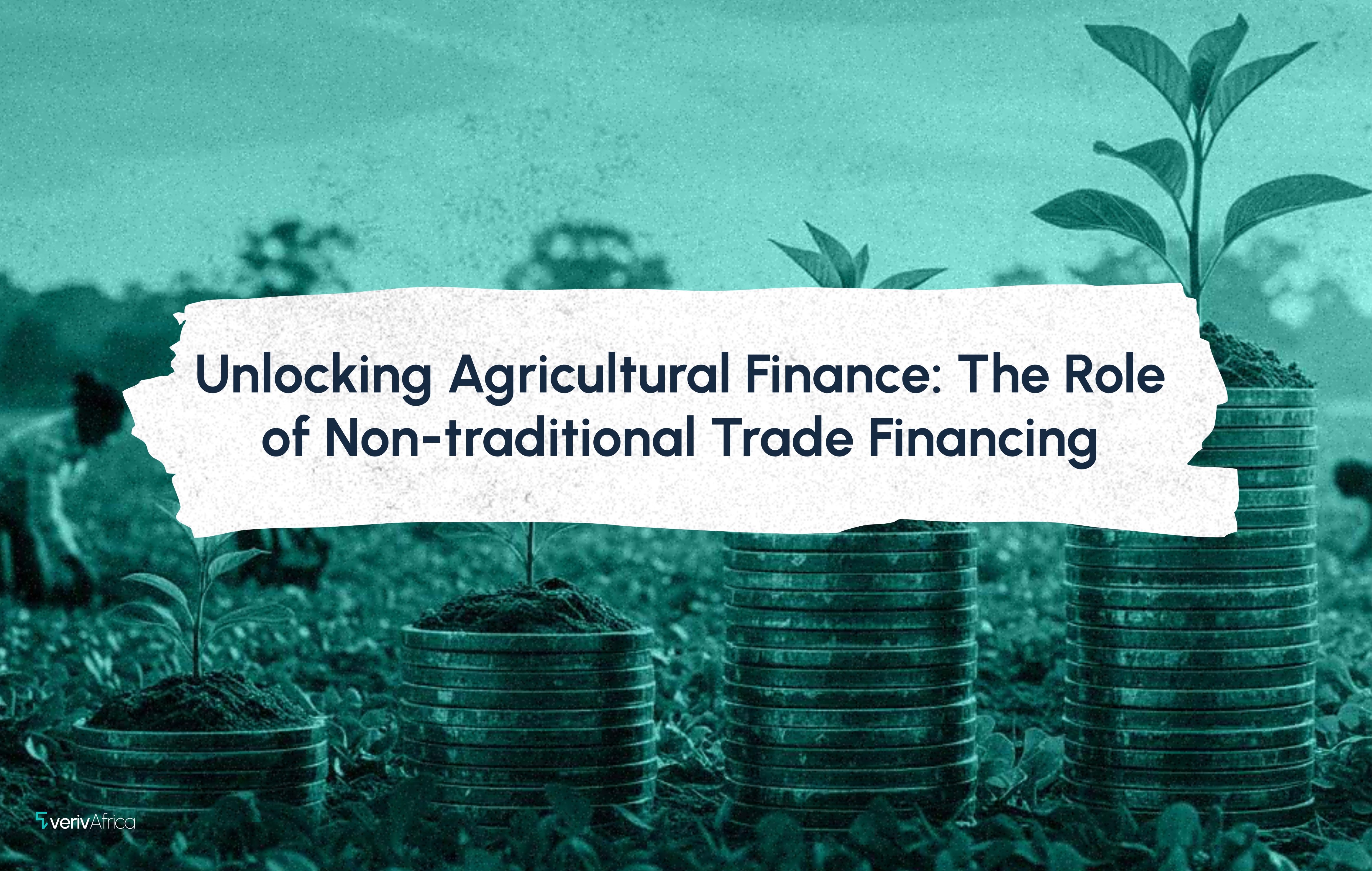Limited access to finance remains a major constraint on Nigeria’s agricultural sector, undermining both the expansion of the non-oil economy and broader economic diversification efforts. The underlying factors affecting access to finance have been detailed in previous Veriv Africa insights, including the role of undocumented land ownership, the lack of identity and residence documents, the absence of local banks in farming communities, the high cost of capital, mainly informally sourced capital, and the last-mile distribution challenge in government-led financing initiatives. Numerous solutions have been proposed to bridge the financing gap. Still, a key priority remains addressing land tenure and documentation issues to unlock the dormant capital tied up in Nigerian land. However, within the general financing challenge, a subset which affects the agriculture sector and other export-facing parts of the non-oil sector is the lack of access to trade and export financing.
Trade Financing & the Trade Finance Gap
Trade finance generally describes a set of financial instruments and products provided to exporters to facilitate international trade transactions. These instruments range from guarantees, such as letters of credit, which ensure payment to the exporter if the buyer defaults, to pre-export financing, which offers additional capital to help exporters acquire the extra inputs needed to fulfil large orders. Trade finance plays a crucial role in facilitating global cross-border trade, which is estimated to be worth $33 trillion in 2024. Key players in the global trade finance industry include commercial banks, merchant banks, private trade finance companies, institutional investors, and government-owned export-import banks, among others. However, despite the plethora of players, a large trade finance gap remains, with demand exceeding supply.
The most recent estimate puts the global trade finance gap at $2.5 trillion. Beneath the figure mentioned above, two statistics stand out. Foremost, small and medium-sized companies (SMEs) suffer a higher trade finance application rejection rate, estimated at 50% of all applications, compared to 7% for larger corporations. The reasons given include poor documentation and higher risk perception, among others.
The second statistic of interest is the size of the trade finance gap in Africa. The Africa Export-Import Bank (Afrexim) estimates the current trade finance gap in Africa at between $80 billion and $120 billion annually. Within the West Africa region, ECOWAS’ leading economies have a combined trade finance gap of about $14 billion, with Nigeria alone accounting for nearly 50% of this figure.
Figure 1: Trade Finance Gap ($ Billion)
Trade Finance and Nigeria’s Agricultural Exports
Given that SMEs account for nearly 96% of Nigerian businesses, their limited access to trade finance significantly constrains agricultural exporters, most of whom fall into this category. This challenge is compounded by broader financing difficulties that persist within the agricultural sector itself. This view has been supported by multiple reports, including the Veriv Africa Food Price Survey Report, where respondents decried the lack of access to financing institutions within a reasonable distance from their farm residences. Farmers and traders who have access to these financing institutions are often unable to access trade finance products due to regulatory restrictions—microfinance banks are barred from forex and international transactions, or the unavailability of trade finance officers in the local branches of commercial banks.
These challenges come on the heels of admirable growth in the agricultural export sector, with crops such as cocoa, cashew, sesame, and ginger forming a sizeable portion of Nigeria’s non-oil export, which grew to $1.79 billion in Q1 and could reach $5 billion by year-end. However, the lack of access to trade finance products and gaps in key knowledge related to the export process and quality requirements frustrate local farmers and farmer cooperatives, leaving them at the mercy of intermediaries who have access to capital and, consequently, keep a sizeable portion of the returns in the value chain. Beyond the impact on farmers' immediate earnings, the continued lack of access to financing, especially trade finance, significantly impacts the growth potential of the agriculture export sector.
What Could Be Done Differently?
As highlighted in previous entries on agricultural finance and land reforms, particularly land documentation, remains at the heart of unlocking credit to the sector. Beyond undertaking broader agricultural reform initiatives, the trade finance challenge in Nigeria, especially for export crops, could be addressed by harnessing alternative capital, in addition to growing the capacity of local banks.. A significant gap in interest rates remains between Nigeria and key financial centres around the world, including North America, Europe, and parts of Asia. Within these centres, there are specialist trade finance firms and general alternative capital providers who are more risk-tolerant if the premium is right. These pools of capital could be harnessed to provide financing to agricultural exporters in Nigeria, with the capital collateralised by the underlying trade value and extra forms of trade insurance. There exists a sizable gap between average returns in the US and other aforementioned centres, as well as interest rate returns in Nigeria today.
The average return on the US S&P 500 over time is estimated at just over 10%, with varying values in each year. Internally, the CBN rates currently stand at 27.5%. Combined with bank premiums on loans, the interest rates paid by companies, especially small and medium-sized enterprises (SMEs), hover around 30% or higher, with even higher values for non-formal loans. Thus, there exists a sufficient gap to provide higher returns to financiers (say 17-20%) while ensuring a relatively lower cost of capital and an ample supply of export financing to local exporters. If harnessed, even at 20% of the existing trade finance gap in Nigeria, these capital sources could provide at least $1 billion in annual export financing to the agriculture sector in Nigeria, enough to supercharge export growth in the industry, with benefits for SMEs, traders, farmers, and the larger economy.
Considering the regulatory barriers to MFBs engaging in international transactions, the aforementioned structure would likely rely on cross-border fintechs, private trade finance companies, and some regional banks with extensive reach in key crop-producing regions within the country. The above financing opportunity would only be effective if key stakeholders, including state and local governments and the National Export Promotion Council, help fill gaps in the export process by expanding education on the export process, providing requisite phytosanitary infrastructure, and other necessary support. If done correctly, the template could be replicated in the manufacturing sector of the economy, with both sectors leading growth in the non-oil sector, thereby expanding the broader economy and creating more jobs.
References
African Development Bank (2023). SMEs’ Demand for Trade Finance in Africa. https://www.afdb.org/en/documents/smes-demand-trade-finance-africa-case-kenya-and-tanzania-volume-14-issue-6
Asian Development Bank (2023). Trade Finance Gaps, Growth, and Jobs Surveys. https://www.adb.org/publications/2023-trade-finance-gaps-growth-jobs-survey
International Finance Corporation (2022). Trade Finance in Africa. https://www.ifc.org/en/insights-reports/2022/trade-finance-in-west-africa
Moniepoint (2025). Small Business Statistics for 2025. https://moniepoint.com/blog/nigeria-small-business-statistics
Nerdwallet (2025). The Average Stock Market Return. https://www.nerdwallet.com/article/investing/average-stock-market-return
Veriv Africa (2025). Nigeria Food Price Survey 2025. https://drive.google.com/file/d/1q2RDfGDR-jt5aIRYfwcGqSBnfq4G2d-0/view










